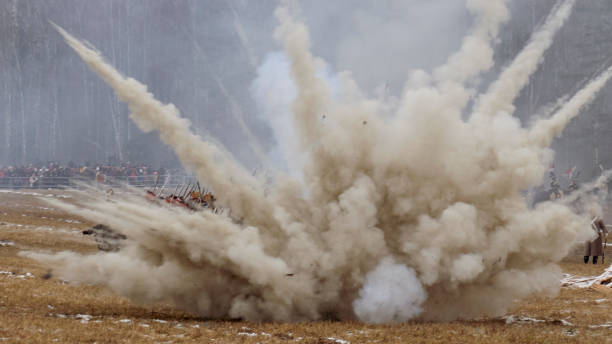
Russia executed a large-scale overnight assault on Ukraine involving missiles and drones, resulting in at least five fatalities and widespread damage to civilian infrastructure including energy facilities across multiple regions, officials confirmed Sunday.
Escalating Winter Campaign Targets Critical Infrastructure
Moscow has intensified attacks particularly targeting Ukraine’s energy grid and natural gas production facilities in recent weeks as the conflict enters its fourth winter season. Diplomatic initiatives aimed at ending hostilities have reached an impasse, prompting increased military aggression.
Four victims from the overnight strikes were family members killed when their residential structure in Lviv, a western region bordering Poland, was completely destroyed, according to local prosecutors. An industrial complex in Lviv’s regional capital caught fire, and significant portions of the city experienced power outages.
Mayor Andriy Sadovyi urged residents Sunday morning to remain indoors as emergency services fought multiple blazes throughout the area. Explosions echoed across the predawn sky as air defense systems engaged incoming threats from various directions.
Governor Maksym Kozytskyi characterized the assault on Lviv as the most extensive attack on the region throughout the entire war, involving 140 drones and 23 missiles. In the village outside Lviv where the family perished, rescue workers sifted through massive rubble piles. Only the building’s foundation remained intact.
Volodymyr Hutnyk, a local official, reported that 10 neighboring homes sustained irreparable damage.
In southeastern Ukraine’s Zaporizhzhia region, one person died and 10 others suffered injuries in a combined strike that left more than 73,000 customers without electrical service. Governor Ivan Fedorov stated that power had been restored to approximately 20,000 customers by early afternoon.
Civilian infrastructure sustained damage across Ivano-Frankivsk, Vinnytsia, Chernihiv, Kherson, Kharkiv, and Odesa regions, Prime Minister Yulia Svyrydenko reported. Ukraine’s energy ministry confirmed that energy facilities in Zaporizhzhia and northern Chernihiv region were damaged. Ukrainian state gas and oil company Naftogaz acknowledged that Russia struck and damaged gas infrastructure but provided no additional specifics.
Russia’s Defense Ministry stated Sunday that its forces targeted Ukrainian military-industrial facilities along with gas and energy infrastructure overnight. Svyrydenko characterized the attack as “another deliberate act of terror against civilians,” writing on social media that Moscow continues striking homes, schools, and energy facilities, demonstrating that destruction remains its singular strategy.
NATO Member States Respond to Airspace Threats
President Volodymyr Zelensky reported that Russian forces launched more than 50 missiles and nearly 500 drones during the assault. NATO member Poland scrambled aircraft early Sunday to safeguard its airspace security.
Poland’s operational command announced through social media that Polish and allied aircraft were operating within their airspace while ground-based air defense and radar reconnaissance systems were elevated to maximum readiness status.
Eastern-flank NATO members maintain heightened vigilance following Poland’s September downing of suspected Russian drones within its airspace. Drone sightings and air incursions, including incidents in Copenhagen and Munich, have created disruptions throughout European aviation operations.
Lithuania’s Vilnius airport closed for several hours overnight after reports of possible balloons approaching the facility late Saturday. According to flight tracking service Flightradar24, commercial flights early Sunday utilized routing patterns typically employed when Poland’s Lublin and Rzeszow airports near the Ukrainian border are closed.
The systematic targeting of energy infrastructure represents a strategic shift in Russia’s military approach as winter approaches. Energy deprivation serves dual purposes: undermining civilian morale and degrading Ukraine’s operational capabilities during harsh weather conditions.
International observers note that these attacks violate principles of distinction under international humanitarian law, which requires combatants to distinguish between military objectives and civilian populations. The deliberate destruction of residential buildings and essential services infrastructure constitutes potential war crimes subject to future accountability mechanisms.
Ukraine’s air defense capabilities have improved significantly since the conflict’s onset, with Western partners providing advanced systems including Patriot batteries and NASAMS. However, the sheer volume of incoming projectiles overwhelms defensive capacity, allowing some strikes to penetrate and cause casualties.
The geographic spread of attacks—spanning from western regions near NATO borders to southeastern territories—demonstrates Russia’s continued ability to project force across Ukrainian territory despite sustained military setbacks in ground operations.
Energy sector targeting also impacts European stability, as Ukraine serves as a transit corridor for natural gas supplies to EU member states. Damage to Ukrainian infrastructure creates ripple effects throughout regional energy markets, contributing to price volatility and supply uncertainty.



